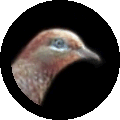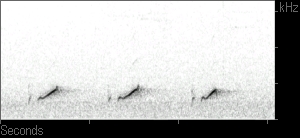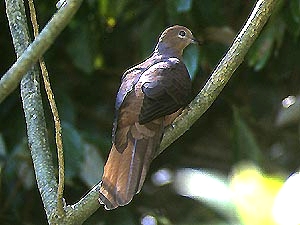 Brown Cuckoo-Dove
Brown Cuckoo-Dove
Macropygia amboinensis
 Figure 1. Spectrogram of the
Brown Cuckoo-Dove song.
Figure 1. Spectrogram of the
Brown Cuckoo-Dove song. (The first three songs from the sound file are depicted.)

Image from Stefan Tewinkel's Bavarian Birds.
Brown Cuckoo-Dove - Macropygia amboinensis
The songs of the brown cuckoo-dove are a plaintive rhythmic cooing. Although they have a gentle timbre, they are very powerful vocalizations that travel a long distance through the rainforest. Like most dove vocalizations, the frequency range of the brown cuckoo-dove’s song is very low, from 500 to 1000 Hz. The song consists of two short syllables, followed by a louder, rising terminal syllable, which is the only syllable audible from a distance. Pizzey and Knight suggest these three syllables sound like ‘did-you-walk?’. Brown cuckoo-doves repeat this 0.7 second song in punctuated song bouts at a rate of one song every two seconds.
Brown cuckoo-doves are among the largest doves in Australia. They are unrelated to cuckoos; they are so named because their long tail is barred on the underside and resembles a cuckoo’s tail in flight.
Habitat.
Brown cuckoo-doves are found in rainforest at both high and low elevations.
Range.
Brown cuckoo-doves are found along the entire eastern coast of Australia, as well as Papua New Guinea, Indonesia and the Philippines.
Further Reading.
G. Pizzey & F. Knight. 1999. Field guide to the birds of Australia. Harper Collins, Sydney.
No recordings, photographs, or other information may be used without written permission (email me at dmennill AT uwindsor DOT ca).